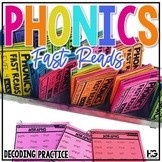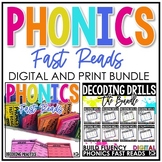CVC Short Vowel Decoding Drills: Real and Nonsense Words | Phonics Fast Reads
- PDF
- Easel Activity
What educators are saying
Also included in
- Are you looking for an extra layer of phonics intervention and instruction to support your students who are struggling with fluency and need help decoding words? Phonics Fast Reads is here to help! Students move through the drills at their own pace, increasing their speed and confidence as they go.Price $27.50Original Price $39.50Save $12.00
- These digital and print decoding drills offer an extra layer of phonics intervention and instruction to support your students who are struggling with fluency. If your students need extra practice decoding words, Phonics Fast Reads are for YOU! Students move through the drills at their own pace, incrPrice $34.50Original Price $78.50Save $44.00
Description
These Short Vowel Phonics Fast Reads are perfect for children who are just beginning to read cvc words or those students who are struggling to decode quickly. Each Fast Read focuses on a short vowel sound and is introduced in a sequence that builds confidence. Students begin by reading short vowel word families. These word families allow students to decode quickly by only having to manipulate the first letter. After reading the word families, students must read a mix up of words with the same vowel sound. The last Fast Read in this bundle includes a mix up of all short vowel sounds! These phonics fast reads work to move students from slowly blending cvc words to a level where decoding is habitual and automatic.
Included:
- short a
- short e
- short i
- short o
- short u
- mix up
Why did I create these Fast Reads?
I created these cards for a few specific first grade students in my own classroom. These students know their letters and sounds but struggle with reading cvc words quickly and automatically. These cards are perfect for the child that is just beginning to blend letters to form words and for the struggling child who struggles with decoding quickly.
The Research
I created these Fast Reads as a way to improve fluency. According the the National Reading Panel, a few things are critical of good reading instruction.
Explicit instruction in phonemic awareness
Systematic phonics instruction
Methods to improve fluency
How do I use these cards in my classroom?
Use them with individual students.
Use them as a warm up in guided reading groups.
Send them home with parents as a tool to practice at home.
These cards are perfect for parent volunteers. It takes all of the guess work out of instruction.
How do I prepare the Fast Reads?
I like to print on cardstock and combine the cards with a metal ring at the top corner. If you are printing so that individual students can take them home, you can print on white paper and staple the side.








